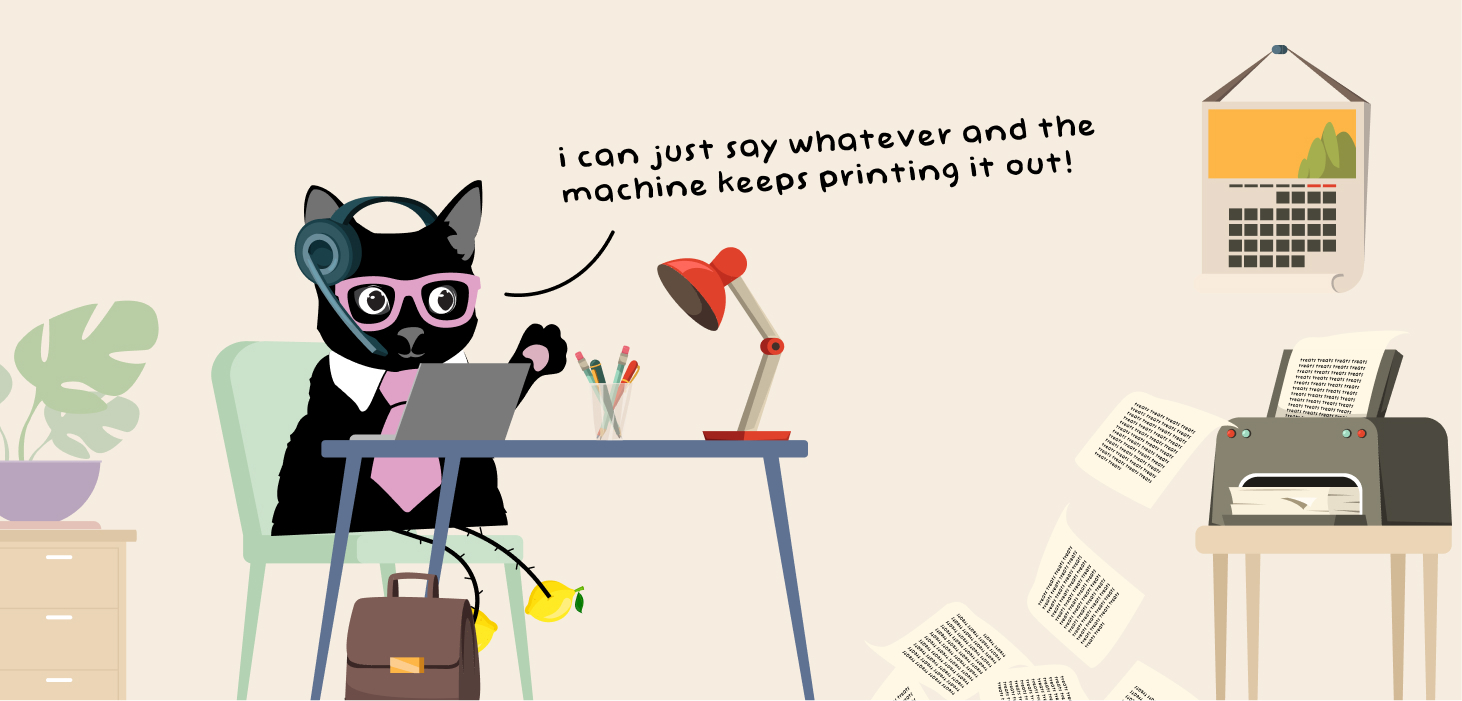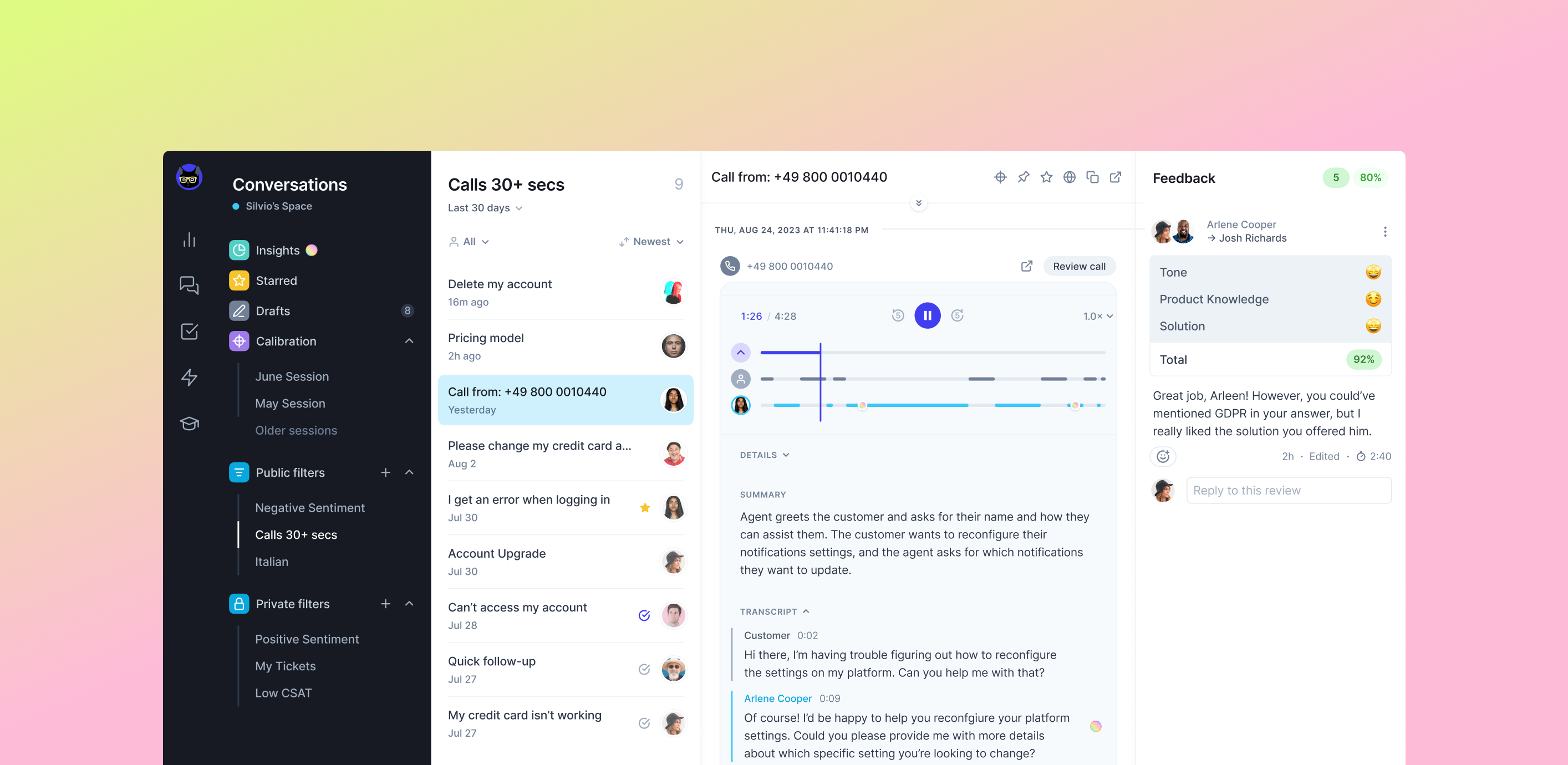Offering support across the channels is not exactly a new concept — 42% of businesses offer two or more support streams. Yet…
If you offer voice support to your customers — great. But don’t forget that it should also be reviewed for quality, just like any other customer service channel.
Which brings us to the next point:
Quality assurance for calls? Enter Voice QA
Voice Quality Assurance (Voice QA for short) is the practice of reviewing and improving the quality of interactions in call centers or customer service settings.
VoiceQA typically comes down to:
- Call sampling: Choosing specific calls to review based on certain criteria or patterns.
- Call monitoring: Keeping tabs on live or recorded calls to see how agents and customers are talking to each other.
- Speech analytics: Using tech to turn spoken words into text to be able to summarise, check customer sentiment, and review calls faster.
In simple terms, voice quality assurance means keeping an eye (or ear) on how well customer service agents talk to customers. By evaluating calls using various quality criteria, you can find ways to improve support, give your team feedback backed by data, and boost customer satisfaction.
The only issue is that call quality monitoring is a time-consuming task — without the tools and tips, that is.

Voice QA tips to improve quality assurance in your call center
Rethink call sampling
How do you choose calls for quality monitoring? If you have no specific method for call sampling, it might be high time to change that.
You could, for example, focus on:
- Complex interactions, where there is a more lengthy back-and-forth and no easy solution,
- New agent conversations, as part of their onboarding process,
- Conversations where the customer gave bad Net Promoter (NPS) or Customer Satisfaction (CSAT) scores.
The trick is to review different types of calls to get your team familiar with various customer service scenarios they might encounter. If you are set on a numerical target, it is easier to express your goal as a percentage of the total volume. This keeps your call center quality assurance reviews statistically relevant as your company grows.
Make sure your review sample is big enough to be representative of the quality trends in your team. Then calculate how many people it will take to listen to this 5-10% of all call recordings and provide meaningful feedback to all agents. – Ahmad Baydoun, Contact Center Manager

Leverage speech-to-text capabilities
Up until very recently, the only way to review calls was to select a sample and just listen to it.
Yet, finding relevant calls to review can be challenging, especially if you don’t have a lot of data about the calls at your disposal. And it’s not even the most time-consuming part of the whole quality monitoring process.
Once you pick the calls to review, it can take a long time for your QA specialists to listen to them carefully, depending on your business and the average duration of incoming calls. Not to mention that such a call quality assurance process is difficult to scale.

Focusing solely on the most insightful conversations and reading transcripts is a much faster and more effective alternative to call center quality assurance.
Speech analytics turns spoken words into text and digs out insights from recorded customer calls, allowing you to look into and understand phone conversations on a big scale. It’s a powerful tool for improving customer service in call centers, especially when used for quality monitoring purposes.
If you’re using a quality management platform, chances are that it offers some speech analytics features like:
- Automatic call transcription — automatically changing what’s said in calls into written words,
- Timestamps and speaker identification — adding time stamps and figuring out who’s talking during a call,
- Call topic discovery — identifying what the conversation is about, and,
- Customer sentiment analysis — figuring out if the customer sounds happy, frustrated, or neutral during the call.
If not, you might want to switch to a better call center speech analytics solution.

Pay attention to your QA scorecard categories
A scorecard is the foundation of your contact center QA framework, so it’s worthwhile to dedicate time to creating a proper one — and iterate whenever needed.
Instead of overwhelming reviews with dozens of questions, concentrate on the aspects of your team’s interactions that matter most to you:
For example, if you are polishing agents’ product knowledge, include “provided accurate product information” as an assessment criterion. Those looking for ways to make their calls feel warmer and friendlier should include a category for “empathy”, and maybe also “appropriate opening and closing lines”.
Interestingly, the average number of rating categories on a scorecard is 14 (although the median is a far more reasonable 8).
If some categories are more important to you than others, make sure to give those categories more weight.
If you need any help with creating and adjusting your call quality monitoring scorecard, download the customer service scorecard template:
Introduce QA calibration to your team
No doubt call quality monitoring is a great way to consistently give helpful feedback to your support representatives and improve the quality of your support interactions. But, no matter how well you’ve trained your team, there’s always a chance that different reviewers score the same conversation differently. That’s just human.
When reviewers are not in sync, inconsistent, or biased in how they grade, your quality metrics become skewed, support reps get frustrated, and there’s no longer a clear path to maintaining quality.
This is where support QA calibration comes in handy to realign things and get you back on the right track.
There are different methods and setups for QA calibrations, but the goal of them is always the same: to make sure all reviewers evaluate calls the same way. That’s how you can make sure that all agents receive the same level of feedback regardless of which reviewer scored their performance.
Make sure to use your review feedback
Here’s one of the most crucial tips for voice quality assurance: Make sure that everything you learn from customer interactions is put to good use — either as feedback for agents or as input for other teams.
Before delving into your team’s call recordings, plan how you’ll use the gathered information. Instead of viewing call center quality assurance as a tool to pinpoint agent mistakes, see it as an opportunity to help your team grow through constructive feedback.
You can use quality assurance insights as:
- Input for 1:1 meetings — use call monitoring as the foundation for giving feedback to your call center agents. Identify areas for improvement, establish specific and time-bound goals, and track your team’s progress from one call to the next.
- Food for thought and self-reflection — agents can improve their performance by analyzing their own support conversations against internal quality standards. According to a study published in the Journal of Business Research, self-assessments boost the quality of customer service and can increase your NPS by 5%.

Give your call center QA framework voice
If you offer phone support, call center quality assurance should definitely be included in your QA process. To make your Voice QA efforts even more effective, we discussed some useful tips for quality assurance calls that you can easily implement, like paying more attention to call sampling, carefully designing your QA scorecards, and putting voice QA tools to good use.
In fact, here’s what quality management solutions like Zendesk QA bring to the table:
- Call transcriptions and summaries make it quick to understand what the interaction was about without listening to it. This helps you decide if the call is worth your review time.
- Automated call sampling and discovery pinpoint exactly which interactions need your attention and what to look out for.
- Sentiment analysis helps determine the conversation’s emotional tone — was the customer satisfied, frustrated, or neutral?
- Powerful voice QA speeds up the call center QA process and improves the coverage of your customer conversations.





